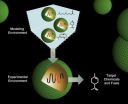Genetic study of black chickens shed light on mechanisms causing rapid evolution in domestic animals
2011-12-23
(Press-News.org) The genetic changes underlying the evolution of new species are still poorly understood. For instance, we know little about critical changes that have happened during human evolution. Genetic studies in domestic animals can shed light on this process due to the rapid evolution they have undergone over the last 10,000 years. A new study published today describes how a complex genomic rearrangement causes a fascinating phenotype in chickens.
In the study published in PLoS Genetics researchers at Uppsala University, Swedish University of Agricultural Sciences, North Carolina State University and National Chung-Hsing University have investigated the genetic basis of fibromelanosis, a breed characteristic of the Chinese Silkie chicken. This trait involves a massive expansion of pigment cells that not only makes the skin and comb black but also causes black internal organs. Chickens similar in appearance to the Silkie were described by Marco Polo when he visited China in the 13th century and Silkie chickens have a long history in Chinese cuisine and traditional Chinese medicine.
We have shown that the genetic change causing fibromelanosis is a complex rearrangement that leads to increased expression of Endothelin 3, a gene which is known for promoting the growth of pigment cells, explains Ben Dorshorst the post-doctoral researcher responsible for the work.
The research group led by Leif Andersson has by now characterized a number of traits in domestic animals, and a clear trend is emerging, namely that genomic rearrangements have contributed significantly to the rapid evolution of domestic animals. Other examples include Greying with age in horses and mutations affecting the size and shape of the comb in chickens.
We have good reason to believe that such rearrangements have also played a significant role in the evolution of other species, including ourselves, concludes Leif Andersson.
The researchers also studied other chicken breeds where fibromelanosis occurs, including the Bohuslän-Dals svarthöna breed from Sweden, and they found that all fibromelanotic breeds carried the exact same very unusual mutation. This finding is consistent with anecdotal evidence suggesting that this Swedish breed of chicken inherited their black skin and internal connective tissue color from Asian chickens that were first brought to Norway by a sailor on the East Asian trade routes centuries ago. This is a nice example of how humans have distributed a single novel mutation with an interesting effect when they developed breeds of domestic animals around the world.
It is obvious that humans have had a strong affection for biological diversity in their domestic animals, says Leif Andersson.
###Illustrations: A Chinese Silkie rooster (Image 1) and a Swedish Bohuslän-Dal's svarthöna hen (Image 2) exhibiting the black skin phenotype. (Photos: Freyja Imsland).
Explanatory note: A genomic rearrangement constitutes an extra copy of a DNA fragment (duplication), a missing DNA fragment (deletion), an inverted copy of a DNA fragment (inversion) or a DNA fragment that has been moved to a new place (translocation). A complex rearrangement involves two or more such changes. The actual mutation in fibromelanotic chickens involves the duplication of two different DNA sequences located in the vicinity of each other on chicken chromosome 20, where one of the copies has also been translocated and inverted.
ELSE PRESS RELEASES FROM THIS DATE:
2011-12-23
A new study describes how a complex genomic rearrangement causes a fascinating phenotype in chickens in which a massive expansion of pigment cells not only makes the skin and comb black, but also results in black internal organs. Published in PLoS Genetics, researchers at Uppsala University, the Swedish University of Agricultural Sciences, North Carolina State University, and National Chung-Hsing University investigated the genetic basis of fibromelanosis, a breed characteristic of the Chinese Silkie chicken.
"We have shown that the genetic change causing fibromelanosis ...
2011-12-23
All life evolved from a single-celled universal common ancestor, and at various times in Earth history, single-celled organisms threw their lot in with each other to become larger and multicellular, resulting, for instance, in the riotous diversity of animals. However, fossil evidence of these major evolutionary transitions is extremely rare.
The fossils, reported this week in Science, preserve stages in the life cycle of an amoeba-like organism dividing in asexual cycles, first to produce two cells, then four, eight, 16, 32 and so on, ultimately resulting in hundreds ...
2011-12-23
One of the most extensive US-based dog training companies, Canine Trade Group, is proud to introduce a new 300 acre training facility in Dover, Delaware where its Professional Dog Trainer's Course will be held. Owned and operated by world-renowned dog trainer John Van Olden, Canine Trade Group offers customized training programs for dog trainers and their dogs. The new Dover Training Facility boasts a private, 20-run climate controlled kennel, an abundance of training field space, as well as accommodations such as on-site lodging or a country inn located less than a mile ...
2011-12-23
Researchers at the Johns Hopkins Malaria Research Institute have demonstrated that the Anopheles mosquito's innate immune system could be genetically engineered to block the transmission of malaria-causing parasites to humans. In addition, they showed that the genetic modification had limited impact on the mosquito's fitness under laboratory conditions. The researchers' findings are published December 22nd in the Open Access journal PLoS Pathogens.
In this study, Dimopoulos and his team genetically engineered Anopheles mosquitoes to produce higher than normal levels ...
2011-12-23
A research team led by Glenn Rall at the Fox Chase Cancer Center in Philadelphia, PA developed a novel mouse model to show that a fatal central nervous system (CNS) disease can be caused by a pathogen that does not replicate in the CNS. The results of this new study are published December 22nd in the Open Access journal PLoS Pathogens.
The authors found that the immune response induced in response to a peripheral viral infection can be "mis-recruited" to the brain, where these activated immune cells can then lead to inflammation-induced neuropathology and disease. While ...
2011-12-23
The computer assisted design (CAD) tools that made it possible to fabricate integrated circuits with millions of transistors may soon be coming to the biological sciences. Researchers at the U.S. Department of Energy (DOE)'s Joint BioEnergy Institute (JBEI) have developed CAD-type models and simulations for RNA molecules that make it possible to engineer biological components or "RNA devices" for controlling genetic expression in microbes. This holds enormous potential for microbial-based sustainable production of advanced biofuels, biodegradable plastics, therapeutic ...
2011-12-23
KANSAS CITY, MO -- Life is complicated enough, so you can forgive the pioneers of DNA biology for glossing over transcriptional elongation control by RNA polymerase II, the quick and seemingly bulletproof penultimate step in the process that copies the information encoded in our DNA into protein-making instructions carried by messenger RNA.
In a new report appearing in the Dec. 23, 2011, issue of Molecular Cell, researchers at the Stowers Institute for Medical Research add not just a new layer, but a whole new dimension to transcriptional elongation control with evidence ...
2011-12-23
Chiropractic Internet marketing strategist and social media expert, Dr. Matthew Loop, has announced he'll continue to show DCs how to create an overwhelming presence on Facebook, which can easily net doctors an extra 20-30 new patients per month just from the social network. Dr. Loop's been helping fellow chiropractors master social media marketing since 2005-2006, which gives him an experience-based edge over other industry consultants.
He's garnered a well deserved reputation as the "go-to" guy for chiropractors that want to dramatically improve their new ...
2011-12-23
December 22, 2011 – Smoking is a well-known risk factor for lung cancer, but nearly 25% of all lung cancer patients have never smoked. In a study published online today in Genome Research (www.genome.org), researchers have identified a previously unknown gene fusion event that could explain a significant proportion of lung cancer cases in never-smokers, and might serve as a target for new therapies.
Recent strides have been made to identify gene mutation events driving cases of lung adenocarcinoma in never-smokers, but the underlying genetic events leading to these lung ...
2011-12-23
In eukaryotes – the group of organisms that include humans – a key to survival is the ability of certain proteins to quickly and accurately repair genetic errors that occur when DNA is replicated to make new cells.
In a paper published in the December 23, 2011 issue of the journal Science, researchers at the Ludwig Institute for Cancer Research and the University of California, San Diego School of Medicine have solved part of the mystery of how these proteins do their job, a process called DNA mismatch repair (MMR).
"One of the major questions in MMR is how MMR proteins ...
LAST 30 PRESS RELEASES:
[Press-News.org] Genetic study of black chickens shed light on mechanisms causing rapid evolution in domestic animals



